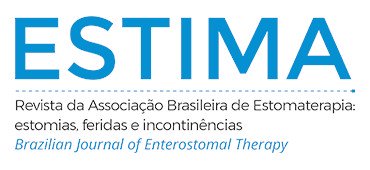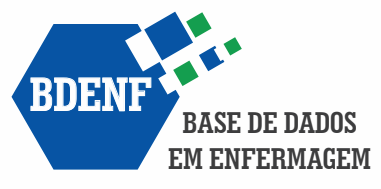CONSTRUCTION OF AN ALGORITHM OF CONDUCT OF SIGNS AND SYMPTOMS IN MALIGNANT NEOPLASTIC WOUNDS IN ADULTS
Abstract
Objective: To build an algorithm of conducts to control signs and symptoms of malignant neoplastic wounds in adults. Method: Methodological research, of an exploratory nature, for the construction-production of a clinical algorithm based on the scoping review. Results: A total of 107 studies was found in the databases, nine of which were included in this review. Four studies are randomized experimental studies, four are case studies and one is retrospective documentary observational study. Odor was the most addressed sign, followed by exudate, bleeding, infection, moisture-associated dermatitis, and pain. Conclusion: Gaps were observed, such as the need for more original and experimental studies, in addition to the lack of a specific descriptor for malignant neoplastic wound. However, it was possible to build an algorithm that offers conducts that are based on the literature for greater theoretical support and nursing safety in relation to cancer patients.
Downloads
Metrics
References
Furka, A, Sinkó C, Kostyál L, Szabó I, Valikovics A, Fekete G, Tornyi I, Oross E, Révész J. Treatment algorithm for cancerous wounds: a systematic review. Cancers. 2022;14(5):1203. https://doi.org/10.3390%2Fcancers14051203
Tsichlakidou A, Govina O, Vasilopoulos G, Kavga A, Vastardi M, Kalemikerakis I. Intervention for symptom management in patients with malignant fungating wounds-a systematic review. J BUON [Internet]. 2019 [acessado em 3 maio 2022];24(3):1301-8. Available at: https://pubmed.ncbi.nlm.nih.gov/31424694/
Probst S, Arber A, Faithfull S. Malignant fungating wounds–the meaning of living in an unbounded body. Eur J Oncol Nurs. 2013;17(1):38-45. https://doi.org/10.1016/j.ejon.2012.02.001
Freitas MS, Pacheco PQ, Souza SR. A qualidade de vida do paciente portador de feridas neoplásicas: uma revisão integrativa. Rev Enferm Atual In Derme. 2019;88(26):1-10. https://doi.org/10.31011/reaid-2019-v.88-n.26-art.438
Bernardinho LL, Matsubara MG. Construção de um instrumento para avaliação do conhecimento sobre ferida neoplásica maligna. Rev Bras Cancerol. 2022;68(1):e-061377. https://doi.org/10.32635/2176-9745.RBC.2022v68n1.1377
Woo KY, Sibbald RG. Local wound care for malignant and palliative wounds. Adv Skin Wound Care. 2010;23(9):417-28.
Salbego C, Nietsche EA, Ramos TK, Girardon-Perlini NM, Lacerda MR, Ferreira T. Concepções sobre tecnologias do cuidar e educar na práxis do enfermeiro hospitalar. R Pesq Cuid Fundam Online. 2021;13:150-7. https://doi.org/10.9789/2175-5361.rpcfo.v13.8669
Barbosa SL, Abud AC, Souza CA, Torres RC, Lima LS, Santos AP. Algoritmos utilizados para o tratamento de feridas. Rev Enferm Atual In Derme. 2019;90(28):1-8. https://doi.org/10.31011/reaid-2019-v.90-n.28-art.523
Pinheiro RV, Salomé GM, Miranda FD, Alves JR, Reis FA, Mendonça AR. Algoritmos para prevenção e tratamento de lesão por fricção. Acta Paul Enferm. 2021;34:eAPE03012. https://doi.org/10.37689/acta-ape/2021AO03012
Firmino F. Pacientes portadores de feridas neoplásicas em serviços de cuidados paliativos: contribuições para a elaboração de protocolos de intervenções de enfermagem. Rev Bras Cancerol. 2005;51(4):347-59. https://doi.org/10.32635/2176-9745.RBC.2005v51n4.1941
Teixeira E (org.). Desenvolvimento de tecnologias cuidativo-educacional. Porto Alegre: Moriá; 2020. v. 2.
Munn Z, Pollock D, Khalil H, Alexander L, Mcinerney P, Godfrey CM, Peters M, Tricco AC. What are scoping reviews? Providing a formal definition of scoping reviews as a type of evidence synthesis. JBI Evid Synth. 2022;20(4):950-2. https://doi.org/10.11124/jbies-21-00483
Tricco AC, Lillie E, Zarin W, O’Brien KK, Colquhoun H, Levac D, Moher D, Peters MDJ, Horsley T, Weeks L, Hempel S, Akl EA, Chang C, McGowan J, Stewart L, Hartling L, Aldcroft A, Wilson MG, Garritty C, Lewin S, Godfrey CM, Macdonald MT, Langlois EV, Soares-Weiser K, Moriarty J, Clifford T, Tunçalp Ö, Straus SE. PRISMA extension for scoping reviews (PRISMA-ScR): checklist and explanation. Ann Intern Med. 2018;169(7):467-3. https://doi.org/10.7326/m18-0850
Harrison H, Griffin SJ, Kuhn I, Usher-Smith JA. Software tools to support titleand abstract screening for systematic reviews in healthcare: na evaluation. BMC Med Res Methodol. 2020;20(1):1-12. https://doi.org/10.1186/s12874-020-0897-3
Lo SF, Hsu MY, Hu WY. Using wound bed preparation to heal a malignant fungating wound: a single case study. J Wound Care. 2007;16(9):373-6. https://doi.org/10.12968/jowc.2007.16.9.27867
Lund-Nielsen B, Adamsen L, Kolmos HJ, Rørth M, Tolver A, Gottrup F. The effect of honey-coated bandages compared with silver-coated bandages on treatment of malignant wounds—a randomized study. Wound Rep Reg. 2011;19(6):664-70. https://doi.org/10.1111/j.1524-475X.2011.00735.x
Kalemikerakis J, Vardaki Z, Fouka G, Vlachou E, Gkovina U, Kosma E, Dionyssopoulos A. Comparison of foam dressings with silver versus foam dressings without silver in the care of malodorous malignant fungating wounds. J BUON [internet]. 2012 [acessed on 28 jan. 2023];17(3):560-4. Available at: https://europepmc.org/article/med/23033299
Lian SB, Xu Y, Goh SL, Aw FC. Comparing the effectiveness of green tea versus topical metronidazole powder in malodorous control of fungating malignant wounds in a controlled randomised study. Proc Singap Healthc. 2014;23(1):3-12. https://doi.org/10.1177/201010581402300102
Silva KR, Bontempo PS, Reis PE, Vasques CI, Gomes IP, Simino GP. Intervenções terapêuticas em feridas tumorais: relato de casos. Rev Bras Cancerol. 2015;61(4):373-9. https://doi.org/10.32635/2176-9745.RBC.2015v61n4.232
Peng L, Dai Y. Effect of metronidazole combined with autolytic debridement for the management of malignant wound malodor. J Int Med Res. 2020;48(4). https://doi.org/10.1177/0300060519889746
Nicodème M, Dureau S, Chéron M, Kriegel I, Trenchand M, Bauer P, Fromantin I. Frequency and management of hemorrhagic malignant wounds: a retrospective, single-center, observational study. J Pain Symptom Manag. 2021;62(1):134-40. https://doi.org/10.1016/j.jpainsymman.2020.11.031
You M, Zhang S, Ma X, Liu H, Lu Y, Li Y. Nursing of a Non-Hodgkin’s Lymphoma patient with a facial malignant fungating wound. Asia Pac J Oncol Nurs. 2021;8(5):581-5. https://doi.org/10.4103/apjon.apjon-2119
Luo B, Xiao Y, Jiang M, Wang L, Ge Y, Zheng M. Successful management of exudate and odor using a pouch system in a patient with malignant facial wound: A case report. Asia Pac J Oncol Nurs. 2022;9(4):236-41. https://doi.org/10.1016/j.apjon.2022.02.006
Santos WA, Fuly PS, Souto MD, Santos ML, Beretta LL. Associação entre odor e isolamento social em pacientes com feridas tumorais malignas: estudo piloto. Enferm Glob [Internet]. 2019 [acessado em 24 fev. 2023];18(1):19-65. Available at: https://scielo.isciii.es/pdf/eg/v18n53/pt_1695-6141-eg-18-53-19.pdf
Mokra D, Joskova M, Mokry J. Therapeutic effects of dreen tea polyphenol (–)-epigallocatechin-3-gallate (EGCG) in relation to molecular pathways controlling inflammation, oxidative stress, and apoptosis. Int J Mol Sci. 2023;24(1):340. https://doi.org/10.3390/ijms24010340
Villela-Castro DL, Santos VL, Woo K. Polyhexanide versus metronidazole for odor management in malignant (fungating) wounds: a double-blinded, randomized, clinical trial. J Wound Ostomy Continence Nurs. 2018;45(5):413-8. https://doi.org/10.1097/won.0000000000000460
Ntow-Boahene W, Papandronicou I, Miculob J, Good L. Fungal cell barriers and organelles are disrupted by polyhexamethylene biguanide (PHMB). Sci Rep. 2023;13(1):2790. https://doi.org/10.1038/s41598-023-29756-w
Borges MS, Peres FI, Moure-Oliveira D, Silva AA, Hori JI. Utilização do mel como terapia complementar: uma revisão sobre as propriedades biológicas associadas ao mel. Braz Appl Sci Rev. 2021;5(2):1027-45. https://doi.org/10.34115/basrv5n2-030
Garcia TF, Silva PG, Barcelos BJ, Miranda MG, Alonso CS, Abreu MN, Borges EL. Critérios para avaliação da qualidade de coberturas de alginato no tratamento de feridas. Rev Bras Enferm. 2021;74(4):e20201091. https://doi.org/10.1590/0034-7167-2020-1091
Downloads
Published
How to Cite
Issue
Section
License
Copyright (c) 2023 Arielly Rosa Dantas Furtado, Tais dos Passos Sagica, Marcos José Risuenho Brito Silva, Clarissa Porfírio Mendes, Alzinei Simor, Odenilce Vieira Pereira, Adams Brunno Silva, Aline Maria Pereira Cruz Ramos

This work is licensed under a Creative Commons Attribution 4.0 International License.

























